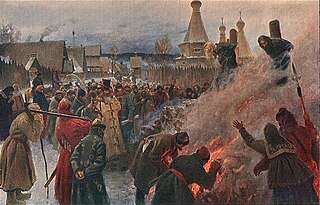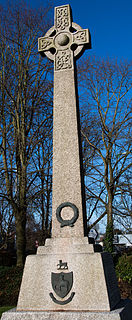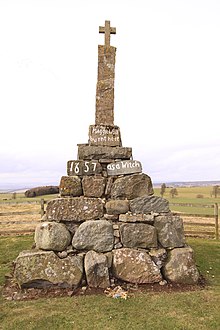
A witch-hunt, or a witch purge, is a search for people who have been labeled witches or a search for evidence of witchcraft. The classical period of witch-hunts in Early Modern Europe and Colonial America took place in the Early Modern period or about 1450 to 1750, spanning the upheavals of the Reformation and the Thirty Years' War, resulting in an estimated 40,000 to 50,000 executions. The last executions of people convicted as witches in Europe took place in the 18th century. In other regions, like Africa and Asia, contemporary witch-hunts have been reported from sub-Saharan Africa and Papua New Guinea, and official legislation against witchcraft is still found in Saudi Arabia and Cameroon today.

Death by burning is an execution method involving combustion or exposure to extreme heat. It has a long history as a form of public capital punishment, and many societies have employed it as a punishment for and warning against crimes such as treason, heresy and witchcraft. The best-known execution of this type is burning at the stake, where the condemned is bound to a large wooden stake and a fire lit beneath.

Dunning is a small village in Perth and Kinross in Scotland with a population of about 1,000. The village centres around the 12th–13th century former parish church of St. Serf, where the Dupplin Cross is displayed. It is in Strathearn, the valley of the River Earn, north of the Ochil Hills. It is just south of the A9, between Auchterarder and Perth.

The North Berwick witch trials were the trials in 1590 of a number of people from East Lothian, Scotland, accused of witchcraft in the St Andrew's Auld Kirk in North Berwick on Halloween night. They ran for two years, and implicated over seventy people. These included Francis Stewart, 5th Earl of Bothwell, on charges of high treason.
The Vardø witch trials, which took place in Vardø in Finnmark in Northern Norway in 1621, was the first major witch trial of Northern Norway, and one of the biggest witch trials in Scandinavia. It was the first of the three big mass trials of Northern Norway, followed by the Vardø witch trials (1651–1653) and the Vardø witch trials (1662-1663), and one of the biggest witch trials in Norway.
The Pappenheimer Case centered around a family who were tried and executed for witchcraft in 1600 in Munich, Bavaria, Germany. The family were executed, along with accomplices they were forced to name under torture, after a show trial as scapegoats for a number of unsolved crimes committed years back in a display of extreme torture intended to given a public example deterring the public from crime. The witch trial resulted in the death of twelve people: four of the Pappenheimer family and two of their accused accomplices in the first trial, followed by the remaining member of the family and five other accomplices in the second trial. The trial was of one of the most well-publicized witch trials in German history.
The witch trials of Vardø were held in Vardø in Finnmark in Northern Norway in the winter of 1662–1663 and were one of the biggest in Scandinavia. Thirty women were put on trial, accused of sorcery and making pacts with the Devil. One was sentenced to a work house, two tortured to death, and eighteen were burned alive at the stake.
The Roermond witch trial, which took place in and around the city of Roermond in the Spanish Netherlands in 1613, was the largest witch trial in present-day The Netherlands. It caused the death of sixty four people by burning.

The Paisley witches, also known as the Bargarran witches or the Renfrewshire witches, were tried in Paisley, Renfrewshire, central Scotland, in 1697. Eleven-year-old Christian Shaw, daughter of the Laird of Bargarran, complained of being tormented by some local witches; they included one of her family's servants, Catherine Campbell, whom she had reported to her mother after witnessing her steal a drink of milk.

The Coventry Martyrs were a disparate group of Lollard Christians executed for their beliefs in Coventry between 1512 and 1522 and in 1555. Eleven of them are commemorated by a six-metre-high (20 ft) monument, erected in 1910 in a public garden in the city, between Little Park Street and Mile Lane; and by a mosaic constructed in 1953 inside the entrance to Broadgate House in the city centre. Some of the streets in the city's Cheylesmore suburb are named after them.

Kate McNiven, also called Kate Nike Neiving or Catharine Niven, was a nurse and accused witch who served the House of Inchbrakie in the Parish of Monzie, near Crieff in Scotland. The date of her death is disputed, ranging from the 16th to 18th century. Louisa G. Graeme, a descendant of the Inchbrakie family, noted in 1903 that no authentic record of McNiven's death existed, and the story has "caused endless discussion and argument".
The Channel Islands Witch Trials were a series of witch trials in the Channel Islands of Jersey and Guernsey between 1562 and 1661.

Witch trials in early modern Scotland were the judicial proceedings in Scotland between the early sixteenth century and the mid-eighteenth century concerned with crimes of witchcraft, part of a series of witch trials in Early Modern Europe. In the late middle age there were a handful of prosecutions for harm done through witchcraft, but the passing of the Witchcraft Act 1563 made witchcraft, or consulting with witches, capital crimes. The first major issue of trials under the new act were the North Berwick witch trials, beginning in 1590, in which King James VI played a major part as "victim" and investigator. He became interested in witchcraft and published a defence of witch-hunting in the Daemonologie in 1597, but he appears to have become increasingly sceptical and eventually took steps to limit prosecutions.

The Steilneset Memorial is a monument in Vardø, Norway, commemorating the trial and execution in 1621 of 91 people for witchcraft. The memorial was designed by artist Louise Bourgeois and architect Peter Zumthor and was opened in 2011. It was Bourgeois' last major work.

Witchcraft in Orkney possibly has its roots in the settlement of Norsemen on the archipelago from the eighth century onwards. Until the early modern period magical powers were accepted as part of the general lifestyle, but witch-hunts began on the mainland of Scotland in about 1550, and the Scottish Witchcraft Act of 1563 made witchcraft or consultation with witches a crime punishable by death. One of the first Orcadians tried and executed for witchcraft was Allison Balfour, in 1594. Balfour, her elderly husband and two young children, were subjected to severe torture for two days to elicit a confession from her.

Beatrix Leslie was a Scottish midwife executed for witchcraft. In 1661 she was accused of causing the collapse of a coal pit through witchcraft. Little is known about her life before that, although there are reported disputes with neighbours that allude to a quarrelsome attitude.
Grissel Jaffray was a Scottish woman burned at the stake in Dundee when accused of witchcraft. She was the last person burned for witchcraft in Dundee.

The Witches' Well is a monument to accused witches burned at the stake in Edinburgh, Scotland, and is the only one of its kind in the city.
Elspeth McEwen or McKewan or Elizabeth MacEwan of Balmaclellan was the most famous convicted witch in Galloway and the last to be burnt at the stake there. An elderly educated woman who lived alone, she was accused of tormenting her neighbours, for example by bewitching their poultry, causing hens, ducks or geese to stop laying, fall ill or die. She supposedly kept a wooden pin hidden in her rafters, which she used to steal milk from any cow by first touching the udder with the pin. In 1696 she was summoned to the local church session on charges of witchcraft. Among the proofs of her guilt was the evidence that the minister's mare, on which she rode to the session, was terrorised and sweated drops of blood.
Margaret Barclay was an accused witch put on trial in 1618, 'gently' tortured, confessed and was strangled and burned at the stake in Irvine Scotland. Her case was written about with horror by the romantic novelist Sir Walter Scott, and in the 21st century, a campaign for a memorial in the town and for a pardon for Barclay and other accused witches was raised in the Scottish Parliament.











